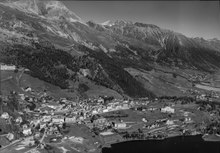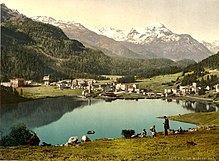St. Moritz
![]()
This article deals with the place in the Engadine. For places of the same name in the French-speaking world, see St-Maurice, for the saint who gave his name, see Mauritius (saint), for St-Moritz churches, see Mauritiuskirche.
St. Moritz (High German [ˌsaŋktmoˈrɪts], Grisons German [ˌsamoˈrits], Rhaeto-Romanic![]() , Italian San Maurizio, local nickname of the inhabitants ils draguns 'the dragons', French Saint-Moritz) is a political municipality in the Engadine, in the Maloja region of the Swiss canton of Graubünden. The place is named after Saint Mauritius, who is depicted in the coat of arms.
, Italian San Maurizio, local nickname of the inhabitants ils draguns 'the dragons', French Saint-Moritz) is a political municipality in the Engadine, in the Maloja region of the Swiss canton of Graubünden. The place is named after Saint Mauritius, who is depicted in the coat of arms.
The municipality is one of the most famous spas and winter sports resorts in the world. Winter Olympics were held here in 1928 and 1948.
Geography
The municipality of St. Moritz consists of the combined districts of St. Moritz-Dorf, St. Moritz-Bad, Suvretta and one half of Champfèr, which is two kilometres away - the other half of Champfèr belongs to Silvaplana.
St. Moritz-Dorf (1822 m) lies on the steep northern shore of Lake St. Moritz, while St. Moritz-Bad (1774 m) and Champfèr (1825 m), through which the River Inn flows, each lie on a plain to the southwest of Lake St. Moritz.
In a south-westerly direction between St. Moritz and Maloja lies the Engadine lake district, which consists of Lakes St. Moritz, Champfèrer, Silvaplaner, Hahnensee and Silsersee. The difference in altitude from Lake St. Moritz to the Maloja Pass, 15 kilometres away, is barely 50 metres. To the east of St. Moritz are the Stazerwald forest and the Charnadüra gorge, through which you reach the next large plain 50 metres lower down, with a gradient of only 60 metres to S-chanf, 20 kilometres away.
The local mountain, which is also home to the winter ski area comprising 23 lifts, is called Corviglia and Piz Nair (3057 m) and lies to the north of the village. Somewhat less well-known and further west, but more imposing due to its height and shape, is the Piz Güglia/Julier (3380 m).
Due to its altitude, the climate of St. Moritz is subarctic (Dfc) with long, extremely cold, snowy winters and short, cool, rainy summers.

Climate diagram for St. Moritz

Aerial view (1954)

St. Moritz with St. Moritzersee and the districts Bad and Dorf
History and tourism
The dating of the larch wood of the prehistoric St. Mauritius spring setting showed that the healing springs were already known in the Bronze Age over 3400 years ago. The presence of the Romans in ancient times is proven by findings.
It took until 1856, when the opening of the first hotel, the Kulm Hotel, marked the beginning of the resort's rise. Thanks to a bet Johannes Badrutt (a St. Moritz hotel pioneer) had made with four Englishmen in September 1864, winter sports also became established. He proposed that the group spend a winter in St. Moritz. In return, they would be allowed to stay for free and for as long as they wanted. If they didn't like it, he would pay their travel expenses (from London to the Engadine and back). The English accepted the bet and stayed from Christmas to Easter.
Thanks to innovative locals and guests, St. Moritz was several times the first municipality in Switzerland to present technical innovations, such as the first electric light (Christmas 1878), the first powered flight in Switzerland (1910) and the first ski lift (1935).
In 1930, St. Moritz was the first resort to have a symbol ("The Sun of St. Moritz") legally protected, and since 1986 the lettering with signet (St. Moritz, TOP OF THE WORLD) has been trademarked. The latter was an initiative of Hans Peter Danuser, the long-serving spa and transport director (from 1978 to 2008).
Singer and entertainer Christian Jott Jenny, who founded the Festival da Jazz in St. Moritz in 2008, has been municipal president since January 1, 2019.

St. Moritz bath, around 1900
Search within the encyclopedia